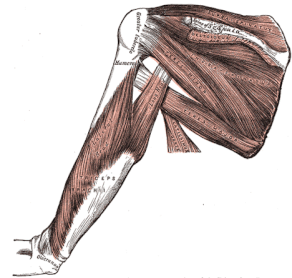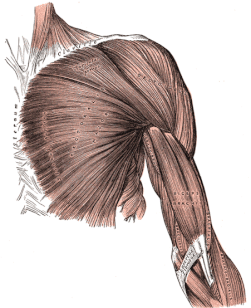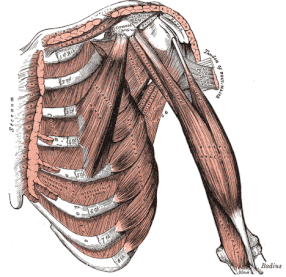Rotator Cuff
The Rotator Cuff is made up of four muscles and their corresponding tendons. These are the Supraspinatus — the most frequently injured Rotator Cuff muscle, Infraspinatus, Teres Minor & Subscapularis. These four muscles surround the shoulder and work together so that the arm can move almost any direction it needs. Bear in mind that there is no joint more flexible than the shoulder. But in order to achieve this high level of flexibility, there has to be a trade off. In the shoulder, stability is sacrificed for flexibility. This makes the shoulder not only the most flexible joint in the body, but also the most unstable.
The shoulder problems that I most commonly deal with are the result of trauma or repetitive activities (jobs, sports, car wrecks, etc). However, it must be understood that in many (maybe even most) cases of Rotator Cuff problems, patients have no real idea what has caused their situation. They just know that they have pain and cannot use their shoulder without pain like they used to. Sometimes these injuries consist of a completely ruptured (torn in half) muscle or tendon. This is a surgical issue unless you just enjoy living in pain. However, people will very often mechanically overload the FASCIA that surrounds not only the individual muscles that make up the Rotator Cuff, but surrounds the entire shoulder as well. Because Fascia is not only the most pain-sensitive tissue in the body, but can’t be seen on MRI (HERE), this damage remains hidden — unseen and frequently completely unrecognized.
As you have already read on our ROTATOR CUFF TENDINOPATHY PAGE, the collagen fibers that make up tendons can, in similar fashion to Fascia, become deranged due to overuse or traumatic injury. This usually occurs without overt damage on MRI as well. These so-called minor sprains, strains, or tendinitis of the Rotator Cuff can be extremely painful to the point of being debilitating. Traditional medical treatment fails because standard therapies such as THE BIG FIVE fail to address the underlying cause of the symptoms. Stretches and strengthening exercises alone are not usually enough to fix the problem, or prevent it from becoming chronic.
Our clinic employs some of the same modern diagnostic techniques and treatment modalities used by professional and college athletic teams. These techniques allow us to determine which part of the Rotator Cuff is injured — or whether or not the Rotator Cuff is even the culprit at all (see link under picture at top right). If scarring is found, we break the microscopic adhesions and SCAR TISSUE and FIBROSIS which has formed around the area of injury.
The typical patient I see will know in a single treatment if their Rotator Cuff problem is going to improve. The patient is first checked for microscopic adhesion and scarring in the shoulder area and Rotator Cuff. If present, it is treated. Patients are then given specific and simple stretches / exercises to perform at home. A single treatment will not be necessarily be enough to solve the problem completely, but you will know whether or not this approach is working. Many people experience relief of symptoms and increased shoulder function immediately after (or even during) their first treatment as you can see from our TESTIMONIALS.
REAR VIEW / SHOULDER The shoulder and Rotator Cuff as seen from the back. At the very top of the picture is the Supraspinatus Muscle. When a Rotator Cuff is injured, the Supraspinatus is the culprit about 95% of the time (Supraspinatus Tendinosis). Remember that a large percentage of what doctors call “Rotator Cuff Injuries”, are not actually injuries to the Rotator Cuff. |
FRONT SHOULDER Superficial Muscles of the Front Shoulder. Many shoulder problems arise in the muscles of the front shoulder and chest, as well as the muscles of the upper arm. Although these pictured muscles are muscles of the shoulder, they are not Rotator Cuff muscles. Remember that most of what is diagnosed as shoulder ‘Bursitis’ is actually Shoulder Tendinosis. |
DEEP FRONT SHOULDER Deep Muscles of the Front Shoulder. As you can guess from looking at the picture, BICEPS TENDON PROBLEMS are a frequent cause of shoulder problems, and commonly misdiagnosed as Rotator Cuff Problems or Rotator Cuff Tendinitis / Rotator Cuff Tendinosis. |
TREATING POST-SURGICAL SHOULDERS
One more thing before we leave this page — Post-Surgical Shoulders. I cannot tell you how many times that I have successfully treated people who have already gone through an unsuccessful Rotator Cuff Surgery (HERE, HERE, and HERE are examples of this). Or even someone who was about to go through an unnecessary surgery (SOME OF THESE FOLKS). Unless your Rotator Cuff is torn in half (some are), you owe it to yourself to try a treatment to see if it will help. I have seen numerous patients over the years who have been told that they have a torn Rotator Cuff (as diagnosed by MRI). However, they responded to my treatment as readily as someone with a fascial injury or tendinopathy.
Of the adult American population walking around with no low back pain; studies have proved that at least 50% of this group have lumbar disc herniations (HERE). We see an almost identical phenomenon with arthritis as well (HERE). The same thing is happening with shoulders. Many people have slightly “torn” Rotator Cuffs that do not cause symptoms. However, when people do something to fire the shoulder up and get it hurting, these tears will of course show up on the MRI. Read what the world’s premiere Sports Physician, Dr. James Andrews has to say about this topic (HERE). The synopsis is that these small tears are convenient scapegoats — something visible and simple that the doctor can point to as the probable cause of pain; and as Dr. Andrews says, a perfect excuse to prescribe surgery. If you are diagnosed with a Rotator Cuff Tear, but then prescribes therapy and exercises to “fix” it; my guess is that although he may not admit it, your doctor feels the same way.
Again, if you have any question as to the validity of your diagnosis of a ‘Rotator Cuff Tear’, have us check it out. Also look at our SHOULDER / ROTATOR CUFF TESTIMONIAL PAGE. Lots of information on Shoulder Tendinosis / Shoulder Tendinitis in our POSTS ON THE SUBJECT as well.
